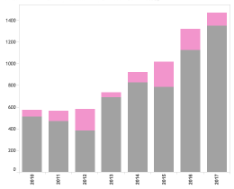Gender equality and development
Development finance for gender equality and women’s empowerment
|
The 2030 Agenda aims for a world where every woman and girl enjoys full gender equality. Achieving gender equality and the empowerment of all women and girls in developing countries requires significantly increased investments. Collectively, donors and partners need to maximise both the quality and quantity of financing to SDG 5: Achieve gender equality and empower all women and girls.
Official Development Assistance (ODA) from the DAC donors is and will remain an important source of financing, especially in the Least Developed Countries. Additional finance has to complement ODA and the full “toolbox” of development finance needs to support gender equality to implement the 2030 Agenda and deliver for women and girls. |
Official Development AssistanceOECD analyses the ODA invested by bilateral donors, which focus on gender equality and women’s empowerment. The DAC members provide yearly reporting on gender focussed ODA, using the DAC gender equality policy marker.
|
||||
Financing for gender equality beyond ODAOECD is expanding the long-standing work on analysing ODA for gender equality to also look at the quality and quantity of private development flows and funding by non-DAC providers. The analysis of wider financing, also for better policies and adaptive approaches, will involve learning and exchange at several levels with GenderNet members, civil society, foundations, and the private sector.
|
||||
Putting finance to work for gender equality and women's empowerment - The way forwardThe 2030 Agenda aims for a world in which every woman and girl enjoys full gender equality and all legal, social and economic barriers to their empowerment have been removed. Without gender equality and women’s empowerment, the Sustainable Development Goals will not be achieved. Yet investments into gender equality and women’s empowerment are lagging behind investments for most other goals. Implementing commitments to gender equality and women’s empowerment requires a range of tools and efforts, all underpinned by financial investments. While ODA remains an essential source of financing for gender equality and women’s empowerment, the Addis Ababa Action Agenda of the Third International Conference on Financing for Development commits development actors to a new way of thinking about financing for sustainable development, and official flows beyond ODA are becoming an increasingly important feature. This paper sets out an overview of what we know about the financing landscape for gender equality and women’s empowerment, a way forward in order to ensure more and better financing for gender equality, and some draft principles to guide future efforts. |
||||
Read the reports
|
||||
Important note on coverage:
The first element to take into account when analysing the data for one country or when comparing data between countries is the COVERAGE RATIO, i.e. the proportion of aid which is screened. A high percentage of gender equality focussed aid alone does not mean that aid is well aligned with the gender equality policy objective; such a conclusion would only be valid for a donor with 100% coverage. When comparing data between donors, both coverage ratio and % of aid focussed on gender equality and women's empowerment have to be considered.
For more information on OECD work on Gender Equality see http://www.oecd.org/gender
Related Documents
